01. Florence the cradle of football
‘Calcio Fiorentino’, played by two teams of twenty-seven players, known today as football in costume, is a centuries old tradition where the date of February 17th 1530 stands out: during the siege of Florence, a match was played to ‘challenge’ the imperial troops that were besieging the city. The playing of the game was regularly maintained until 1739 and was resumed at the turn of the twentieth century, between 1898 and 1902. It is because of this consolidated tradition that Florence has been declared the cradle of football.
02. FROM THE SOCIETY OF FOOTBALL TO FIORENTINA
In the final years of the nineteenth century, as was also the case in Genoa, Milan and Turin, the interest in the new game known as football also developed in Florence, but thanks to the Florentine history, it was immediately called calcio, while in the same year (1898) the Italian Football Federation was founded in Turin, which in 1909 changed its name to Federazione Italiana Giuoco Calcio – F.I.G.C.
The Honorary President of the Società del Giuoco del Calcio (called Florence Football Club by the English community) was the then mayor of Florence, the Marquis Pietro Torrigiani. The game developed, initially at the San Donato park, and then on the Oaks lawn at the Cascine. Numerous teams emerged, of which the most important was, until the First World War, Firenze Football Club.
In the first post-war period, the teams of the Club Sportivo Firenze, founded in 1870 and which gave birth to the football section in 1908, and the Palestra Ginnastica Fiorentina Libertas, established in 1877 and which had a football section since 1912, established themselves.
The ’Whites’ of the Club Sportivo and the ‘Reds’ of the Palestra Ginnastica Fiorentina Libertas didn’t manage to reach the First Division, but they fought for the first place in the city also in fiery derbies, repeatedly refusing merger proposals to join forces in a unique city club.
Both clubs each had their own fortnightly publications, two ‘House Organs’ that helped to fuel the rivalry: ‘Il Ghiozzo rosso’ for Libertas, and ‘Il Clubbista’ for Club Sportivo.
Between 1919 and 1922, both clubs played in the Tuscan First Division, with the new rankings of 1922/23 they both played for two seasons in the Second Division North Group F, but in 1923/24 Club Sportivo were relegated to Division Three.
The fourth place obtained by Libertas in the 1925/26 Second Division, allowed entry, with the reform of the leagues, to the National First Division. On August 2, 1926, the ‘Viareggio Paper’ changed the organization of Italian football, finally defining a competition on a national basis.
The birth of the Associazione Fiorentina del Calcio, on August 29, 1926, was an obligatory decision, strongly desired and imposed by the Marquis Luigi Ridolfi: the city of Florence has a duty to be a protagonist in this new scenario, which is why the forces of the P.G.F. Libertas and the Club Sportivo were to be merged into one club. Fiorentina was the result of an extraordinary operation, conducted personally by Ridolfi, one of the greatest and most far-sighted of Italian sports managers.
The first new shirt chosen, was ‘quartered’, half white and half red, adorned with the red lily on a white field, symbol of the city, and the sporting title of the P.G.F. Libertas was used.
03. THE TWENTIES
The first seasons, played at the velodrome field of the Palestra Ginnastica Fiorentina Libertas, in Via Bellini, represented the hard price to pay: the original vices of the clubs which had given life to Fiorentina needed to be overcome, and initially they were represented equally in the new club. The first three championships, including the so-called ‘settling in’ one in 1928/29 which gave rise to Serie A, were disappointing. President, almost by obligation, of the new-born Fiorentina, Marquis Luigi Ridolfi, took over the leadership completely in the immediate years after, taking upon himself all of the sporting, organizational and financial responsibilities. The result was the construction of a football team capable of competing at the highest level of Italian Serie A football.
04. 1929 PURPLE SHIRT
On Sunday September 22nd 1929, in the stadium in Via Bellini, Fiorentina, to prepare for the Serie B championship, played a friendly match against Roma (won 3-0 by the Giallorossi), but the most important result of the day was the new shirt colour worn by Fiorentina; purple. The shirt, already worn two days previously in a game between a mixture of Fiorentina and Empoli, represented a precise sign of the change brought about by the Marquis Ridolfi to the club.
A radical change was needed: in the running of the club, taken over directly by Ridolfi and no longer co-managed by representatives of the old clubs; in the management of the team, entrusted to the Hungarian, Feldmann; in the construction of the squad, with the arrival of Galluzzi, Renzo Magli, Neri, Pizziolo, equipped to gain experience in Serie B, so as to aim for promotion the following year; in the colour, choosing one that was unique and unmistakable in the football world: purple. Fiorentina organised its own supporters, with the birth of the Order of the Marzocco, which adopted the Marzocco Lion as its symbol, of which Ridolfi himself was appointed President.
05. 1931: SERIE A, THE STADIUM, THE ANTHEM
In 1930/31, Fiorentina won the Serie B championship and achieved promotion to Serie A.
Ridolfi had enthusiasm and great determination, but, most of all, the awareness that ‘men pass, walls remain’. This was how the stadium was born, initially named after “Giovanni Berta”, to the high standards of the architectural tradition of Florence. A ‘jewel’, for the period, designed and built by the young architect Pier Luigi Nervi. It’s the stadium that still accompanies Fiorentina today. At that time the stadiums were built using public money, but the municipality of Florence didn’t have enough, and it fell to Ridolfi to contribute decisively, by mortgaging and selling his own assets. On September 13th, 1931, it was officially inaugurated by the friendly match Fiorentina vs Admira Vienna (1-0). It was the crowning of a dream that followed the realisation of another dream: Fiorentina in Serie A.
On November 22nd, 1931, before the game with Roma, the ‘Canzone Viola’ was played, which would become the Fiorentina anthem.
06. THE THIRTIES
The Austrian Hermann Felsner, who had already won two championships with Bologna, was the coach chosen for Serie A. Waited on at the Genoa docks, arrived the ‘artillero’ Petrone, Olympic and World champion forward with Uruguay: the defensive midfielder of the national team, Pitto, was bought, and other players such as Gazzari, Bigogno, Prendato and Busini; Mario Pizziolo already played with Fiorentina, the first World Champion Viola, with Pozzo’s Italy in 1934. Petrone scored 25 goals and was the first Fiorentina player to become top-scorer (together with Schiavio). Fourth place, in their Serie A debut, showed that the Italian league had not just found a participant, but a new protagonist. Petrone, not very inclined to discipline, left Fiorentina in March 1933, but the building of a squad capable of challenging for the title was only delayed. After a couple of good seasons, the big chance presented itself in the 1934/35 season. Trained by Guido Ara, the glory of Vercelli and Italian football, the Viola began like a rocket, and, despite the serious injury which ruled out Arrigo Morselli, they became Winter Champions.
In the second round Fiorentina paid for the absence of alternatives to first team players, and the inexperience in battling for the Scudetto. In the end, their third-place finish doesn’t give the idea of a goal within reach: two games from the end the squad was in full fight for the title. In the following years the situation became dramatic due to the lack of financial means. The answer was the ‘Squadra Primavera’, green in years and flighty in play, that would become a constant of the Viola team: up until 1932 Fiorentina organized the ‘First kicks’ tournament to select young players. The relegation in 1937/38 was mainly down to financial difficulties, but the following year Ridolfi managed to find the resources to return immediately to Serie A, under the technical guidance of the Austrian Rudolf Soutschek. The squad was completely revolutionised and amongst the new players, the right winger Romeo Menti and the goalkeeper Luigi Griffanti stood out.
07. THE FORTIES: THE FIRST VICTORY
On June 10th 1940, Italia entered into war. A few days later, June 16th, the Viola team lifted its first ever Coppa Italia, beating Genoa in the final (on whom fascism had imposed the name Genova 1893) with the decisive goal from Celoria. In the previous rounds the Viola had eliminated, along with Polisportiva Cavagnaro di Sestri Ponente, Milan, Lazio and Juventus. In this team played an unbeatable right winger, who together with another ten phenomena, wrote the legend of the Great Torino,always keeping his love for the Viola in his heart and in a pin on the lapel of his jacket; Romeo Menti.
This is the line-up for the final: Griffanti; Da Costa, Piccardi; Ellena, Bigogno, Poggi; Menti, Morselli, Celoria Baldini, Tagliasacchi.
Fiorentina, trained by Giuseppe Galluzzi, a Florentine and ex Viola player, had adopted, the only Italian team apart from the red and blue of Genoa, the WM, the ‘System’ that came from England and was changing the way football was interpreted.
The league continued until the country became overwhelmed by the war, and, in September 1943, invaded by the Germans. The war also left behind heavy losses in the world of football, including three ex Fiorentina players; Armando Frigo (an officer of the Italian army, he was shot by the Nazis in Dalmatia in October 1943), Bruno Neri (partisan commander killed by the Germans in the Romagna Apennines on July 10th 1944) and Vittorio Staccione (died in March 1945 in the prison campo where he was deported for his political ideas).
08. 1944: ASSOCIAZIONE CALCIO FIORENTINA
These were dramatic times in which Fiorentina suspended its activities. At that time Ottavio Baccani, Fiorentina secretary and director, guaranteed the organisational continuity of the club by transforming his own home into the headquarters of Fiorentina and becoming, since September 1944 (Florence was liberated on August 11th 1944) the hub of the reorganisation, carried out in agreement with the Municipality. Fiorentina was reconstituted, it became the Associazione Calcio Fiorentina, many people joined and they elected Arrigo Paganelli as president. A lot of players returned immediately to wear the purple shirt.
Among them Ferruccio Valcareggi, whose technical ability was second only to his humanity; Carlino Piccardi, ‘the boy from Campo di Marte’, and a young boy that, after a great career, returned as a Fiorentina director; Egisto Pandolfini. The stadium, which became the ‘Comunale’, was occupied by the armies, and the Fiorentina squad had to sort out their own trainings and activities. On April 2nd 1945, the Tuscan Championship started, won by Fiorentina who beat Livorno in the final, played on July 29th at Santa Croce sull’Arno.
09. THE AFTER WAR
In 1945/46 the National league resumed, with the teams divided into two groups. Fiorentina (Centre-South Group) finished in fifth place, failing to qualify for the final phase.
In 1946/47 Fiorentina managed to save themselves at the last moment. They were difficult years, marked by major financial difficulties which led to a quick succession of presidents: Paganelli, Cassi, Allori.
The presidency of Antonini, which began in April 1948, brought about a phase of economic consolidation and technical growth. The decisive step was the choice of the coach: Luigi Ferrero arrived in the Summer of 1947 and gave a new imprint to the team, where, alongside Augusto Magli and Valcareggi, Eliani, Galassi and Acconcia emerged strongly. The five consecutive defeats in the final games and a seventh place finish dampened the enthusiasm, but the path chosen by Ferrero was to focus on the best young players, in 1948 Pandolfini also returned to Fiorentina. The club tried, with little luck, to strengthen the squad with the signing of foreign players. After the eight place in the year of the Superga disaster, the Viola obtained two fifth place finishes in 1949/50 and 1950/51. Ferrero would remain on the Fiorentina bench until November 1951, when he would be replaced by the ex-Fiorentina player Renzo Magli who would finish the league in fourth place.
10. THE VIOLA WALL
Ferrero built the Viola defensive wall which was the basis of the Fiorentina successes. After having coached for two years the Great Torino winning two league titles, he accepted the Fiorentina bench in the Summer of 1947. In 1948/49, with the arrival of Rosetta and Cervato, construction of the ‘wall’ began. Rosetta was the first stone, he immediately became the new centre half-back, followed by Cervato who began as a first team player the next year.
The same year ‘Nardino’ Costagliola had also arrived between the Fiorentina posts. It was 1949/50 when Chiappella arrived, a right midfielder signed from Pisa, of who Ferrero, halfway through the season, changed his position: defensive midfielder. Magnini was signed from Pistoiese in 1950. He was a midfielder, raised as an attacking midfielder, but Ferrero, impressed by his physical strength and acrobatic ability, redesigned as a full-back. He became first choice in 1951/52 with Renzo Magli as trainer.
11. THE FABULOUS FIFTIES
On December 24th, 1951, a new board of directors was elected, which appointed Enrico Befani as president, a rich and ambitious industrialist from Prato. Finally, the investments arrived to take Fiorentina to the top of Italian football. In the mid-fifties Fiorentina revolutionised the football hierarchy by winning the league title of 1955/56.
At the base of their successes there was a double innovation: organisational with Befani who knew how to choose, spend well and build an avant-garde and technical club with the bench entrusted to Fulvio Bernardini in January 1953. The right year seemed to be 1953/54, but Fiorentina, first in the table, collapsed at the end. In the end, the ‘Doctor’ found the right recipe to win, adopting that which would come to be known as the ‘Half System’: in the winning Fiorentina side, Chiappella was the fourth defender and Prini the winger. A group made up of great players, starting with Julinho, and a line-up memorised by generations: Sarti; Magnini, Cervato; Chiappella, Rosetta, Segato; Julinho, Gratton, Virgili, Montuori, Prini, to which we need to add the other Champions of Italy: Toros, Bartoli, Carpanesi, Mazza, Scaramucci and Bizzarri, but especially Orzan, future Fiorentina captain, who played in 18 of the 34 games.
It was also the year of the first European success: on October 3rd 1956 (7-2 against Schalke 04), and the Viola mathematically won the Grasshoppers Cup, a gruelling international tournament (1952-1957) contested by six clubs from different countries. An era of enormous satisfaction, with the national team tinged with purple, but also one of great regrets. Fiorentina became the first Italian club to compete in a European Cup final, reached by eliminating: Norrköping, Grasshopper, Red Star. The final was played in Madrid, May 30th 1957, in front of more than 120,000 spectators and the Spanish dictator, Franco. The Viola were beaten by the great Real, with Di Stefano and Puskas, and by the refereeing of the Dutchman Horn, who, twenty minutes from the end, at 0-0, awarded a penalty to the home side for a foul which happened outside the area.
Those regrets grew in the following years, marked by four consecutive second places, in one of which, 1958/59, they scored 95 goals. Kurt Hamrin had taken the place of Julinho, other defenders, Robotti and Castelletti, joined Chiappella. A double defeat also in the Coppa Italia finals, in 1958 against a Lazio trained by Bernardini, and in 1960, in extra-time against Juventus.
In 1959 and 1960, Fiorentina contributed to the Italian victory in the Italian-French Friendship Cup.
12. THE SIXTIES
The four second places wore Befani out, and exhausted the faith that the club board had in him. At the end of the controversial 1960/61 season, which they ended in seventh place, there was the troubled handover between the two Enrico’s, from Befani to Longinotti.
In the midst of the heated discussions of the club board, the team had a surge of pride and finished the season in an overwhelming fashion. First, the victory in the Cup-Winner’s Cup, conquering Ibrox and beating Glasgow Rangers in the two-legged final (2-0 and 2-1). Albertosi; Robotti, Castelletti; Gonfiantini, Orzan, Rimbaldo; Hamrin, Micheli, Da Costa, Milan, Petris, the men who contested the double header, with ‘Gigi’ Milan the matador: the two goals in Scotland were his as was the first in Florence, where Hamrin scored the winning goal. Fiorentina became the first Italian team to win a UEFA European competition. A few days later they won the Coppa Italia, beating Lazio 2-0 in the final, with just one change from the Cup-Winner’s Cup line-up, Marchesi as defensive midfielder instead of Rimbaldo. In 1961, Fiorentina also contributed to the Italian victory in the Coppa delle Alpi Italo-Svizzera, while a young Raffaele Righetti joined the club, destined to become a real cornerstone in the next fifty years of Fiorentina history.
In the following years, Fiorentina unfortunately failed to fulfil their promise. The 1961/62 season ended with a third-place finish, which, in light of how the league went, was disappointing. Aurelio Milani was the top-scorer with 22 goals, together with Altafini. The European Cup-Winner’s Cup Final, after the draw with Atletico Madrid, was replayed at the start of the following season and Fiorentina lost convincingly (3-0). Sixth in the table, while in 1963/64 and 1964/65, with Alberto Orlando as the top-scorer with 17 goals alongside Sandro Mazzola, Fiorentina twice finished in fourth place. In 1965 Fiorentina were beaten by Vasas Budapest in the final of the Mitropa Cup.
The turning point for the club came in February 1965, with the presidency of Nello Baglini. Radical changes were introduced: in the running of the club; on the sporting side, beginning with the youth sector to challenge clubs unreachable in the financial field; with the organisation of fans in the Viola clubs and the monthly publication of Alé Fiorentina. The result of which was the Fiorentina ye-ye, shaped by Beppe Chiappella, who won the 1966 Coppa Italia, beating Catanzaro in the final (2-1) having knocked out Genoa, Palermo, Catania, Milan and the great Inter, World Champion.
This was the line-up for the final: Albertosi; Pirovano, Rogora; Bertini, Ferrante, Brizi; Hamrin, Merlo, Brugnera, De Sisti, Chiarugi, with a Hamrin goal and the decisive penalty scored by Bertini in extra-time.
Still in 1966, June 19th, Fiorentina won the Mitropa Cup, beating the Czechoslovakian side Jednota Trencin in the final.
In the Summer of 1968, important players were sold: Albertosi and Bertini of the National Team, and the great prospect Brugnera; Kurt Hamrin had left Fiorentina the previous Summer, joining Milan in an exchange for Amarildo. The team, entrusted to Bruno Pesaola, surprised everybody, winning the league title of 1968/69. Here are the Champions of Italy: Superchi, Rogora, Mancin, Esposito, Ferrante, Brizi, Chiarugi, Merlo, Maraschi, De Sisti, Amarildo, Rizzo, Bandoni, Cencetti, Danova, Mariani, Pirovano, Stanzial.
13. THE SEVENTIES
They began with the second appearance in the European Cup and elimination in the quarter-finals against Glasgow Celtic. The winning of the second Scudetto wasn’t followed up, the financial stability wasn’t there to remain at the top of Italian football. The 1970/71 league was marked by a major club board crisis which brough the team to the brink of relegation, only avoided on the final day of the season. Baglini left the presidency to Ugolino Ugolini who based his mandate on a new youth policy. The bench was entrusted to the maestro Liedholm, who stayed for two years rebuilding the team and finishing in fifth and fourth place. In 1973/74 Radice was appointed, which brought a year of ‘Dutch’ football, giving great hope, but the club didn’t have faith and decided to go with Nereo Rocco. Between him and Mazzone, with Mario Mazzoni on the bench, they won, in a final against Milan (3-2), the 1974/75 Coppa Italia.
This is the team chosen for the decider: Superchi; Beatrice (46’ Lelj, 47’ Rosi), Roggi; Guerini, Pellegrini, Della Martira; Caso, Merlo, Casarsa, Antognoni, Desolati, with goals from Casarsa, Guerini and Rosi with the winner.
Still in 1975, Fiorentina won the Anglo-Italian Cup, with two wins, both 1-0. In the two-legged tie with West Ham.
The best finish in the league table in the Seventies was third in 1976/77. There were seasons which also had a painful downside: the accident which ended the playing career of Vincenzo Guerini and the injury which ended the career of Moreno Roggi. In those years the crowd followed the extraordinary performances of Giancarlo Antognoni. The second half of the decade saw the team and the fans clinging to their Number 10, managing to save themselves, again on the final day, in the 1977/78 season, with Chiappella back on the bench and the debut of Giovanni Galli in goal. On September 29th 1979, the president Melloni died, who at the end of 1977 had taken the place of Ugolini and was replaced by Enrico Martellini.
14. THE EIGHTIES
The Pontello family bought Fiorentina in 1980, promising big investments and success. In the Summer of 1981, a marketing operation without precedent was launched, the lily was redesigned, an untouchable symbol for the Florentines, and new shirts were created from revolutionary design.
Pecci, Graziani, Massaro, Monelli and Vierchowod were signed, to bolster the squad, which had already brought in Daniel Bertoni the previous year, world champion in 1978 with Argentina. The 1981/82 season seemed to be the right one, despite the serious injury to Antognoni, to go from words to actions. The Viola, guided by ‘Picchio’ De Sisti on the bench, battled for the Scudetto the whole campaign, the title vanished on the final day, between disallowed goals and penalties not given, leaving behind a trail of controversy which has never subsided.
In the following years, the signings of Passarella and Socrates, captains of Argentina and Brazil, the bringing in of Italo Allodi as director, didn’t produce the desired effects, despite the great play produced in the 1983/84 season, finished in third place. In the second half of the decade, Pontello’s disengagement was progressive, with the selling of the best players, Passarella, Galli, Massaro, Diaz and Berti.
On December 5th 1987, Pier Cesare Baretti died in a aeroplane crash, he had been called by the Pontello family a year before to run the club. Baretti, a man of great depth, had his own, fascinating, idea of football orchestrated by Sven Göran Eriksson on the bench and supported by the young Fiorentina talents, with whom he was looking to the future. The Pontello era ended in the worst way: the defeat in the UEFA Cup Final of 1990 against Juventus, the selling of Roberto Baggio to the bianconeri, the fans and the city in revolt.
15. THE NINETIES
‘Marione’ Cecchi Gori was enthusiastically applauded by the Viola fans as the new owner and president.
In 1991 the stadium was named after Artemio Franchi, the greatest Italian football director, partner, fan and ex Secretary of Fiorentina. After two years of acclimatisation, beginning with the Brazilian coach, Lazaroni, on the bench, Fiorentina seemed ready to return to the top. Baiano alongside Batistuta; the German captain Effenberg, replacing Dunga; the new European Champion Brian Laudrup, and the Italian international Di Mauro. In January of 1993, the temper of Vittorio, the son, destroyed everything, also sacking the manager Radice: the season ended with an incredible relegation to Serie B, 54 years after the first one. Cecchi Gori kept the strongest players and chose Ranieri as coach to begin a new cycle.
The climb from B began, while unfortunately Mario Cecchi Gori passed away, on November 5th 1993, his son Vittorio succeeding him as president.
Fiorentina challenged for important goals, becoming one of the ‘seven sisters’ of Italian football. They were the years of the Batistuta machine-gun, top-scorer with 26 goals in 1994/85, of Rui Costa, of Toldo. Fiorentina returned to winning the Coppa Italia in 1995/96, collecting eight wins from eight games, the Italian Supercoppa, at the San Siro against Milan.
The Cup-Winner’s Cup adventure ended in the semi-final against Barcelona, ending the Ranieri cycle. The new manager chosen was Alberto Malesani. The coach won over the fans, but didn’t bond with Vittorio, who a year later wanted Trapattoni on the bench to win the league title. The third place in 1998/99 had the bitter taste of the Batistuta injury and the escape by Edmundo for the Brazilian Carnival. An unlucky season which ended with the defeat in the Coppa Italia final won by Parma after two draws. The following year Fiorentina had a great Champions League, but lost Batistuta, who having beaten the club record for goals in Serie A, announced his departure from Florence.
Faith Terim arrived on the bench, and inflamed the Fiorentina fans, but soon clashed with Cecchi Gori who called Roberto Mancini to replace the Turkish coach.
Fiorentina won, beating Parma in the final, the 2000/01 Coppa Italia.
It was the final moment of Cecchi Gori’s management in which football is spoken of: the 2001/02 season ended with relegation to Serie B and the bankruptcy of the club.
On August 1st 2002, the Associazione Calcio Fiorentina no longer existed.
16. THE DELLA VALLE ERA: ACF FIORENTINA
The F.I.G.C established that the sporting title belonged to the Municipality of Florence and that the new club would need to begin again from C2. The Della Valle family took over ‘Florentia Viola’, set up by the Mayor, Domenici, and in an epic year, with a team that no longer had its proper name or shirt, and at the start not even players, broke every record for season tickets in the category (16,648).
Di Livio, just returned from the 2002 World Cup with Italy, chose to remain in Florence. The promotion to C1, with Cavasin on the bench (he replaced Vierchowod after a few rounds) and Riganò the goal-scorer, was followed by the inclusion in a 24 team Serie B, for sporting merit. At the end of the 2003/04 season, after a play-off with Perugia, the great dream came true: Fiorentina, with its proper name and shirt, managed by Emiliano Mondonico, returned to Serie A.
The year of the Serie A return, 2004/05, turned into a terrible season. Fiorentina were caught in the grip of referees led by the underworld and only survived on the final day. After the damage came the insult: the fourth place in 2005/06, with Toni scoring the goals and Prandelli on the bench, was wiped out by a thirty points deduction. Fiorentina, victim of a corrupt system, were heavily punished because the Della Valle family had met with the top referees to understand what was happening behind their backs. A fifteen points deduction also accompanied the team the following season, finishing in sixth place (they would have been third without the deduction). With Frey, Mutu, Ujfaluši and many other top players, Fiorentina settled themselves regularly in the top half of the table, also reaching the semi-final of the UEFA Cup in 2008, and competing in two editions of the Champions League, 2008/09 and 2009/10.
Diego Della Valle, who entered the world of football with the aim of reforming it, but instead dragged into legal matters, distanced himself from Fiorentina and the team suffered heavily. After the anonymous 2010/11 season, the situation imploded the following year with the real risk of relegation.
Once that scare was overcome, Andrea Della Valle restarted things with a new cycle, with important players and Montella on the bench: three consecutive fourth place finishes meant competing as protagonists in the Europa League, culminating in the semi-final of 2015; in 2014 Fiorentina were beaten by Napoli in the Coppa Italia Final, played in Rome in a surreal atmosphere after it was delayed due to serious incidents outside the stadium.
In the final years, the Della Valle family increased their detachment from Fiorentina, limiting its interest to the financial running of the club and renouncing any sporting ambition. In January 2016, the team, trained by Paulo Sousa, reached second place after the first round, but the owners chose not to intervene in the January transfer window to strengthen it adequately. The last three seasons saw Fiorentina’s progressive decline and a complete split between organized fans, only interrupted by the sudden and dramatic death of Davide Astori, March 4th 2018, when Fiorentina were in Udine before the Udinese-Fiorentina game. A man, a captain, and an unforgettable date in our history.
17. VIOLA RENAISSANCE: THE ARRIVAL OF ROCCO COMMISSO
On June 6th, 2019, Rocco Commisso bought Fiorentina. His first appearance at the stadium was greeted by massive crowds. ambition, enthusiasm, attachment to the club colours, Viola pride, all reflect the message of the new owner, who in just a few months has defined the agreements for the construction of a new Sports Centre; keeps the strongest players and shows his intentions with big signings, starting with that of Ribery. An ownership connected and aware of its surroundings, ready to send messages of solidarity when needed, with its ‘Forza e Cuore Viola’ campaign, launched in the midst of the Covid-19 pandemic.
The first season under the new owner ended with avoiding any risk and taking the team to tenth place, in the top half of the table.






























